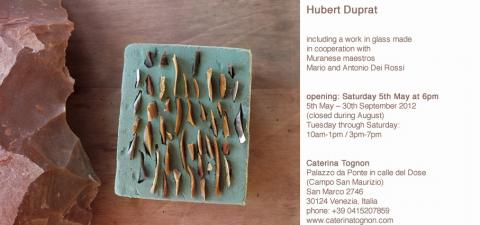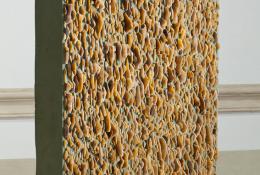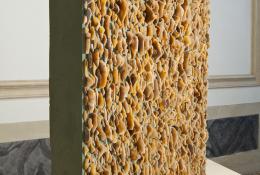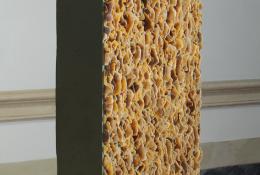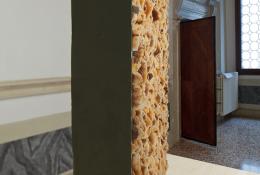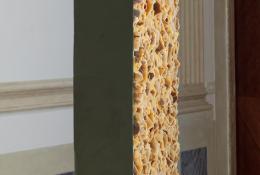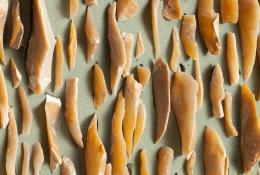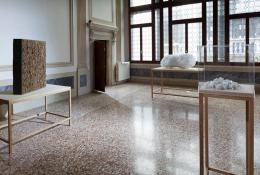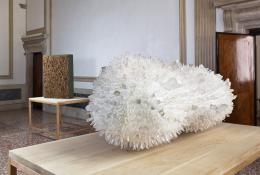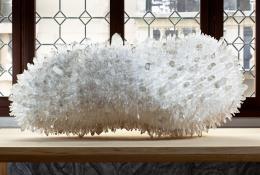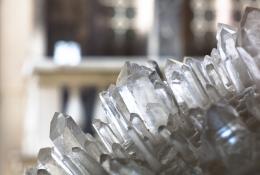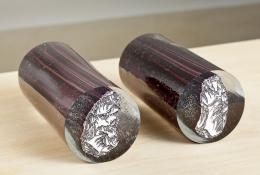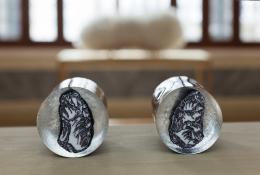Hubert Duprat
Hubert Duprat came to Venice in February 2011, having been invited by the gallery and as a result of Simone Menegoi’s generous proposal. His visit was dedicated to Murano and its furnaces, and to understanding its ancient glassblowing techniques. Among the craftsmen there, he met 85-year-old Mario Dei Rossi, the last master glassblower who, with his son Antonio, is capable of creating “cold- composition murrine”. It was this technique that would arouse the artist’s imagination.
Almost a year later, Duprat took two front and back technical drawings depicting a Palaeolithic spear point in flint from an old encyclopaedia, and asked for two murrine to be created from these drawings. Thus began the Dei Rossi father and son team’s patient work of creating the glass micro-mosaics and then “pulling” them in the furnace to obtain two canes containing the miniature version of the original drawings throughout their length.
Thanks to the two master glassblowers’ craftsmanship, with this work Hubert Duprat has managed to transpose one of prehistoric man’s first creations (the spear point in flint) into one of the most complex creations of Venetian craftsmanship: the murrina.
The chemical composition of glass, which is mostly silica powder, closes the circle.
“L’oeuvre d’Hubert Duprat, par bien des aspects, semble l’exploration même des frontières historiquement et culturellement établies entre l’Art et ses formes secondes, artisanales, populaires ou décoratives. Dans son travail, l’artiste fait plus volontiers référence à l’histoire des arts et des techniques qu’à celle de l’art. En effet, lorsqu’il emprunte, non sans lui faire subir de multiples métamorphoses, un motif ou une technique, c’est à la fresque, à la tapisserie, à l’enluminure ou à l’objet décoratif, non au tableau et à la sculpture. Ainsi, Hubert Duprat joue des connotations et des usages culturels liés à des activités qui, relevant du mode mineur de la création, sont le plus souvent exclues du champ de l’art moderne et contemporain [...]. L’artisan est étymologiquement “celui qui exerce un métier”, le mode de production artisanal impliquant des savoir-faire manuels lies à des exercices précis. Ce sont souvent des compétences techniques de ce type, nécessitant une méticulosité certaine, qui sont requises pour la fabrication des oeuvres d’Hubert Duprat. De fait, contrairement à la plupart des créateurs actuels, lui bannit la quantité, limitant le nombre d’objets quand bien même ils constituent une série. Hubert Duprat maintient la distinction, effective depuis que le terme d’artisan s’emploie (au milieu du seizième siècle), entre cette activité et celle de l’artiste. Ce dernier délègue en effet la plus grande part de la réalisation à des mains plus ou moins expertes selon ce que l’oeuvre implique de difficultés particulières. L’un des obstacles rencontrés par Duprat est de trouver des artisans (ou ceux qui en font office) prêts à mettre leurs capacités au service de travaux pouvant paraître aberrants. L’artiste laisse très peu de part créative à ses collaborateurs [...]. Réactualisant certains procédés abandonnés au cours du vingtième siècle - et sur ce plan il est bien un artiste d’après la modernité - Hubert Duprat réconcilie l’art et l’artisanat. Chez lui, la creation n’est pas jouée contre la tradition ni l’Art contre le métier. Aussi son travail permet-il d’ouvrir la question artiste/artisan à celle, plus large, de l’artistique et de l’artisanal”.
Les métiers d’Hubert Duprat di Natacha Pugnet da Les Figures de l'art, n°7, 2004
As it happens with the Murrine piece, also in Sans Titre, Dés et Uléxite, we can observe a composition where the image is “travelling”. The artist glued some pieces of ulexite on each side of the dices. This special mineral that can be found at only one site in the U.S. has the peculiar property to carry visual information without transforming it. Therefore the value on the surface remains visible without any change in size, irrespective of the thickness of the stone.
The exhibition at the gallery shows a second new piece, Sans Titre, made up of a polymer foam parallelepiped into which numerous flint fragments have been set. The artist collected them in Le Grand-Pressigny in central France, a region famous for the remains and artefacts dating back to the end of the Stone Age found there. The work combines a strictly mineral element, flint, with an extremely pliable synthetic one, the sponge used for flower arranging.
“Larve Aquatique de Trichoptère avec son Etui” is also in the show. This work, with which Hubert Duprat made his debut in the 1980s, continues to have great
resonance today due to its conceptual complexity. It is a
work inspired by entomology in which the larva of an aquatic
insect, the caddis fly, is removed from its natural habitat to
an artificial habitat made up of gold specks, small pearls and
precious stones. Rather than creating its protective casing
with detritus found on the riverbed, the insect is forced to
use the materials surrounding it. In doing so, it creates
veritable precious micro-sculptures. 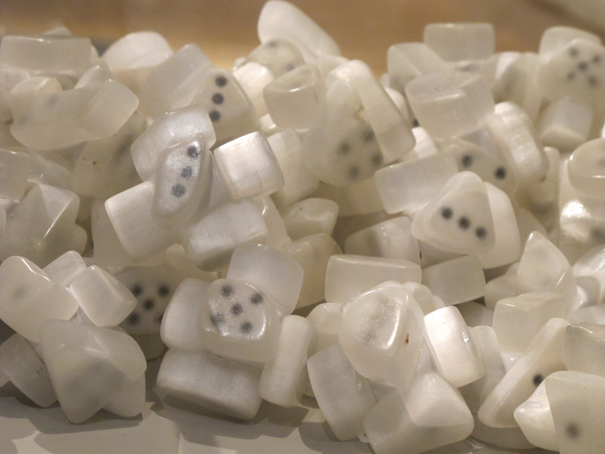
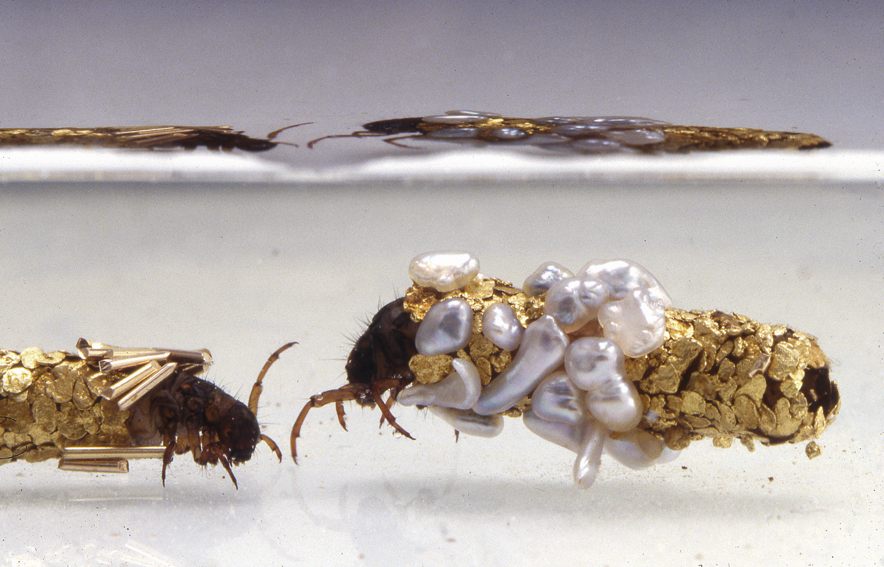
HUBERT DUPRAT | SHORT BIO
Born 1957. He lives in the south of France.
A self-taught artist, he has been active since the 1980s.
His personal show at the Art Concept gallery in Paris has just closed.
He is participating in the “Micromania” exhibition at the Gagosian Gallery in Paris until 12 May: an exhibition of small-scale sculptures by the foremost artists of the twentieth and twenty-first centuries.
From 4 June, at the Ecole des Beaux Art of Geneva and curated by Christian Besson: the “Le miroir du trichoptère” exhibition dedicated to the vast bibliographical and documentary collection about caddis flies collated by the artist.
